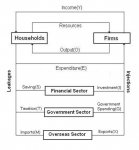- Joined
- May 12, 2014
- Messages
- 6,815
- Reaction score
- 4,420
- Gender
- Male
- Political Leaning
- Liberal
Circular flow of income - Wikipedia
GDP = C (consumption) + I (investment) + G (government spending) + (X - M) (net exports, positive or negative)
Production = national income = potential demand.
If you have a $15 trillion economy, the national income is $15 trillion. If we spent 100% of our income buying our own production, then we would remain a $15 trillion economy.
But, as a whole, we never spend 100% of our income. How, then, does the economy grow, when aggregate demand needs to grow?
By additions to aggregate demand over and above the income from previous production. This can come from four places:
*net spending out of savings. (This never happens.)
*a trade surplus. (This never happens in the U.S.)
*federal deficit spending.
*increased private sector debt. (This normally happens in a good economy.)
Subtractions to aggregate demand include savings, trade deficits (which is just saving by foreign parties), a federal budget surplus, and decreased private sector debt.

Simply put, if additions to aggregate demand outweigh subtractions to aggregate demand, the economy grows. If subtractions outweigh additions, the economy shrinks. $1 billion in federal deficit spending or increased credit will result in more than $1 billion of income, because there will be some secondary spending effects. (This is all assuming that about 100% of deficit spending and increased credit goes to consumption and investment, but that's a pretty safe assumption.)
Also, banks do not lend out our savings.
Discuss.
GDP = C (consumption) + I (investment) + G (government spending) + (X - M) (net exports, positive or negative)
Production = national income = potential demand.
If you have a $15 trillion economy, the national income is $15 trillion. If we spent 100% of our income buying our own production, then we would remain a $15 trillion economy.
But, as a whole, we never spend 100% of our income. How, then, does the economy grow, when aggregate demand needs to grow?
By additions to aggregate demand over and above the income from previous production. This can come from four places:
*net spending out of savings. (This never happens.)
*a trade surplus. (This never happens in the U.S.)
*federal deficit spending.
*increased private sector debt. (This normally happens in a good economy.)
Subtractions to aggregate demand include savings, trade deficits (which is just saving by foreign parties), a federal budget surplus, and decreased private sector debt.

Simply put, if additions to aggregate demand outweigh subtractions to aggregate demand, the economy grows. If subtractions outweigh additions, the economy shrinks. $1 billion in federal deficit spending or increased credit will result in more than $1 billion of income, because there will be some secondary spending effects. (This is all assuming that about 100% of deficit spending and increased credit goes to consumption and investment, but that's a pretty safe assumption.)
Also, banks do not lend out our savings.
Discuss.
